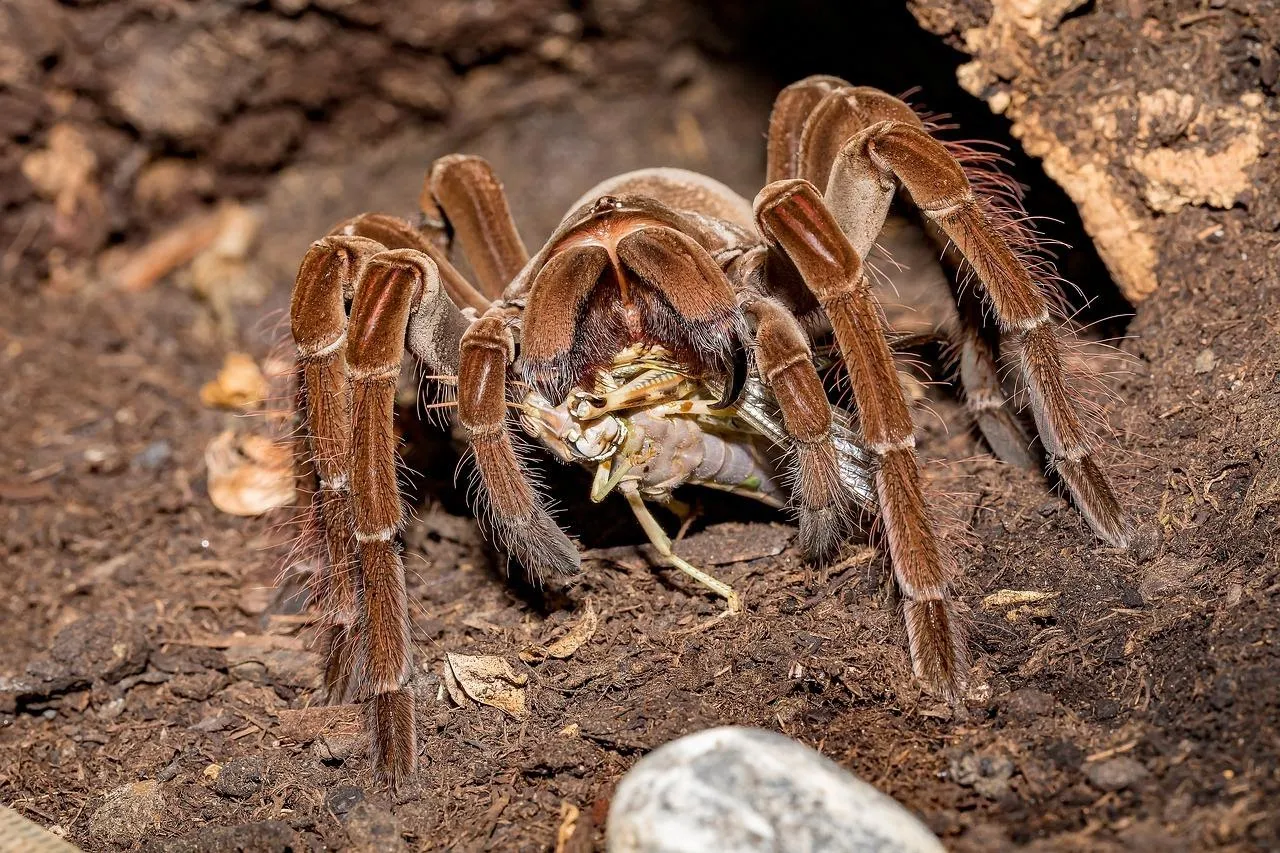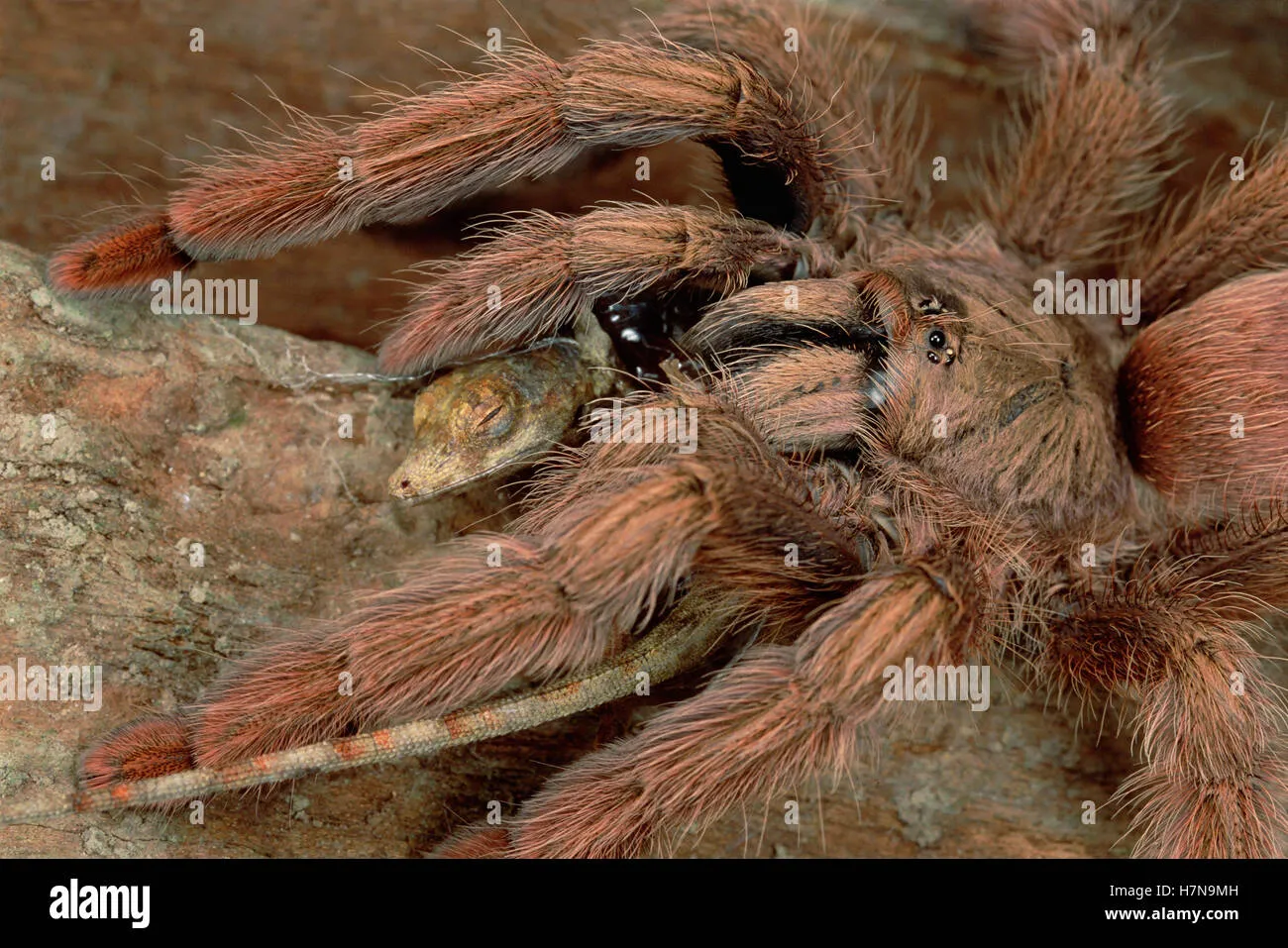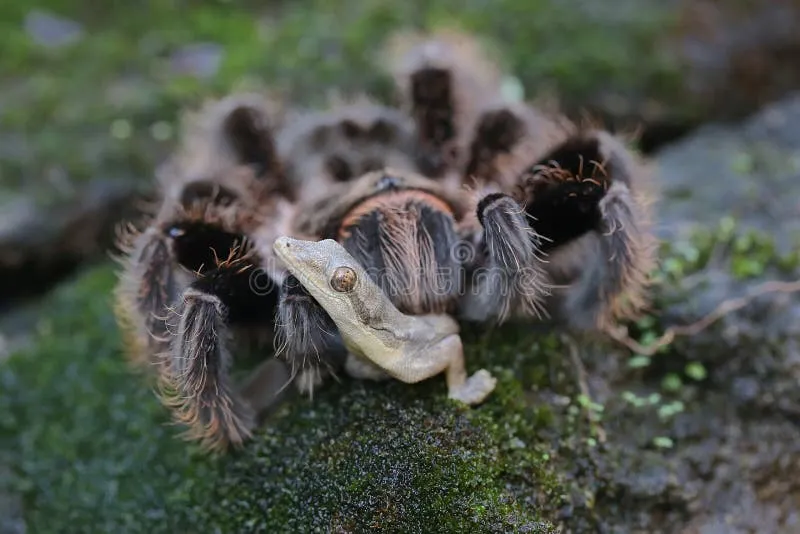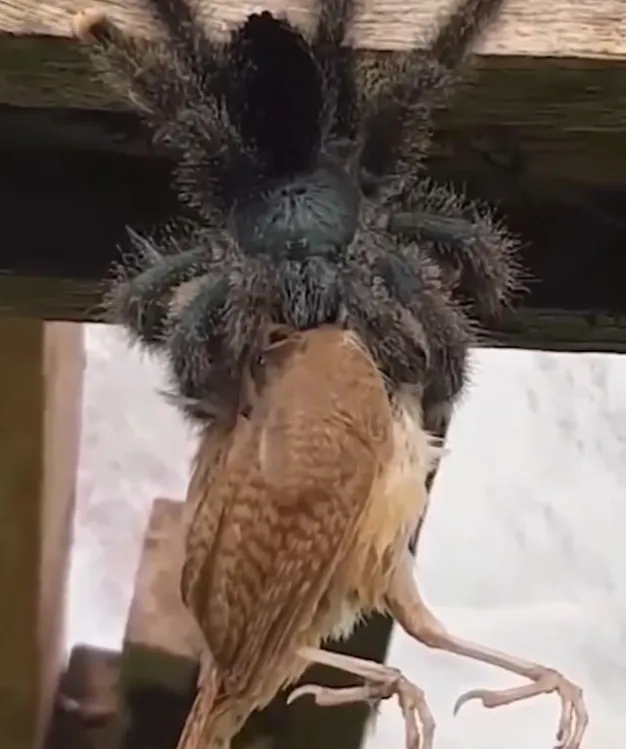Why Tarantulas Eat Lizards
The dramatic encounter of a tarantula eating a lizard is a captivating spectacle of nature’s raw power. This predatory behavior isn’t merely a display of size and strength but a fundamental aspect of survival for these large arachnids. Understanding why tarantulas engage in this behavior involves looking at various factors, including the tarantula’s size, hunting techniques, and the nutritional benefits a lizard provides. The tarantula’s world is a delicate balance of predator and prey, and the lizard sometimes finds itself in the unfortunate role of a meal. This section delves into the reasons behind this fascinating, yet often brutal, interaction.
Size Matters The Tarantula’s Advantage
Size is a critical factor in the tarantula’s ability to hunt and consume lizards. Larger tarantula species, often with leg spans exceeding several inches, possess the physical strength and reach necessary to subdue and overpower a lizard. The size disparity is a significant advantage; while a small lizard might be quick and agile, it’s no match for a tarantula’s powerful fangs, venom, and overall bulk. The tarantula’s exoskeleton provides protection, and their sheer size allows them to effectively ambush and secure their prey, setting the stage for a successful hunt. The tarantula’s physical attributes are a primary reason why they can successfully prey on lizards.
Lizard Species Tarantulas Prey On

Not all lizards are equally vulnerable to tarantula predation. The specific lizard species that tarantulas target depend largely on geographic location, habitat, and the size of both the predator and the prey. Smaller lizard species, or juvenile lizards of larger species, are more susceptible to tarantula attacks. The tarantula’s ability to successfully hunt lizards often hinges on the availability of suitable prey within its environment. In some regions, common targets might include anoles, geckos, or skinks. The specific lizard species in a tarantula’s diet can offer insights into the complex predator-prey dynamics within the tarantula’s ecosystem.
Tarantula Hunting Techniques
Tarantulas are not active hunters like some other predators. They often employ a sit-and-wait strategy, relying on their camouflage and patience to ambush prey. This patient approach is essential to their hunting success. They typically wait near their burrows or in areas where prey is likely to pass. When a suitable lizard wanders close, the tarantula swiftly attacks. The tarantula’s hunting techniques are refined over time and are integral to their survival. The ability to remain still for extended periods and then launch a rapid attack is a testament to the tarantula’s predatory prowess.
The Ambush Strategy
The ambush strategy is a cornerstone of the tarantula’s hunting success. They often position themselves in hidden locations, such as under rocks, within burrows, or amongst dense vegetation. When a lizard moves within striking distance, the tarantula quickly springs into action, delivering a precise and powerful attack. The element of surprise is critical; the lizard rarely has time to react before the tarantula’s fangs are embedded. This method of hunting is highly effective, allowing tarantulas to conserve energy and maximize their chances of a successful hunt. The ambush strategy is a testament to the tarantula’s patient approach to securing a meal.
The Venomous Bite

The tarantula’s venomous bite plays a pivotal role in subduing prey. Their fangs are not only used for piercing the lizard’s skin but also to inject a potent venom. This venom contains a cocktail of toxins designed to paralyze and begin the digestive process. The venom breaks down the lizard’s tissues, making it easier for the tarantula to consume its meal. The venomous bite is an essential component of the tarantula’s hunting strategy. It immobilizes the prey, allowing the tarantula to safely consume the lizard. The effects of the venom vary depending on the tarantula species and the lizard, but its purpose remains the same: to ensure a successful hunt.
Why Lizards Make a Good Meal
From a nutritional perspective, lizards offer a balanced meal for tarantulas, providing various essential nutrients necessary for survival and growth. The lizard’s body is rich in protein, fats, and other vital substances. These elements are critical for the tarantula’s development, molting, and overall health. Lizards provide a substantial source of energy, which helps tarantulas maintain their high-activity lifestyle. The tarantula’s preference for lizards is a reflection of the prey’s nutritional value. This choice is crucial for the tarantula’s survival in the wild. Lizards are a well-rounded food source, enabling tarantulas to thrive in their habitats.
Nutritional Value of Lizards
The nutritional content of lizards is a key factor in their appeal as prey for tarantulas. Lizards are an excellent source of protein, essential for the growth, repair, and maintenance of the tarantula’s tissues. They also provide healthy fats, which are critical for energy storage and various physiological functions. Additionally, lizards contain a range of vitamins and minerals, such as calcium, that are important for the tarantula’s exoskeleton and overall health. Lizards offer a balanced nutrient profile, supporting the tarantula’s well-being. The nutritional richness of lizards makes them a valuable food source, contributing to the tarantula’s survival and vitality.
Tarantula’s Digestive Process

Tarantulas do not have teeth and must digest their prey externally. After subduing a lizard, they inject digestive enzymes into the prey. These enzymes break down the lizard’s tissues into a liquid form, which the tarantula then sucks up. The digestive process is a slow but efficient method of extracting nutrients from the prey. Once the lizard is completely consumed, all that remains is the indigestible parts, which the tarantula discards. The digestive system is uniquely adapted to handle large, solid meals. The tarantula’s specialized digestion system enables them to make the most of the nutritional value of each meal.
The Survival Benefit of Predation
Predation plays a vital role in the survival and reproductive success of tarantulas. Consuming lizards and other prey provides essential nutrients and energy necessary to thrive in their environment. Predation is not merely a means of sustenance; it’s a fundamental aspect of their survival strategy. The ability to successfully hunt and consume prey directly impacts a tarantula’s ability to reproduce and pass on its genetic traits. This section will delve into the survival and reproductive advantages that result from preying on lizards, highlighting the impact of this behavior on the tarantula’s overall life cycle.
Energy Gain
The act of predation gives tarantulas a crucial energy boost. Lizards provide a high-energy meal, with a significant amount of calories to sustain their activities. This energy is vital for a number of key functions, from hunting to molting and reproduction. The ability to obtain a sufficient amount of energy influences the tarantula’s activity levels and health. The energy gained from eating lizards directly influences their ability to survive and thrive in their environment. The more energy a tarantula can extract from its meals, the better its chances of surviving and reproducing.
Reproductive Advantage

Successful predation also contributes to a tarantula’s reproductive success. Adequate nutrition, obtained by preying on lizards, is crucial for females producing viable eggs and for males to have the necessary energy to mate. Well-fed tarantulas are more likely to have successful reproductive cycles, leading to larger clutches of eggs and healthier offspring. Predation therefore supports the continuation of the species. The nutritional benefits that result from eating lizards play a key role in ensuring that future generations of tarantulas thrive.
Are All Tarantulas Lizard Hunters?
While many tarantula species are known to prey on lizards, it’s not a universal behavior. The diet of a tarantula is highly adaptable and can depend significantly on various factors, including their species, habitat, and the availability of prey. Some tarantulas may primarily eat insects, while others may have a more varied diet that includes lizards, small mammals, or even other arachnids. The complexity of tarantula diets helps to define the ecological roles they play within their habitats. This section will explore the circumstances that dictate the dietary choices of tarantulas. It also provides insights into the ways in which they hunt and the prey they target.
Factors Influencing Predatory Behavior
Several factors influence a tarantula’s predatory behavior. The size of the tarantula is a key determinant; larger species are more likely to hunt larger prey, including lizards. Habitat plays a critical role, as the types of prey available in a specific location shape the tarantula’s diet. Availability and abundance of lizards influence a tarantula’s hunting choices. Additionally, individual preferences and learned behaviors can also influence which prey a tarantula targets. The interplay of these elements determines how each tarantula hunts, what it consumes, and its overall lifestyle.
Habitat and Diet Variations

The habitat in which a tarantula lives directly influences its diet. Tarantulas in environments with a high lizard population may have more opportunities to hunt them. In contrast, tarantulas in habitats with fewer lizards might rely more heavily on insects or other small animals. Variations in diet showcase the adaptability of tarantulas. They are able to adjust their hunting strategies to meet their nutritional needs. The habitat and diet variations of tarantulas demonstrate their adaptability. The ability to change the food source based on what is available is essential for survival.
Tarantula Behavior and Instincts
Understanding the behavior and instincts of tarantulas is crucial to appreciating the dynamics of their predation on lizards. Tarantulas are primarily driven by instinct, with their hunting strategies deeply embedded in their genetic makeup. The ways that tarantulas hunt, react to threats, and select their prey are shaped by millions of years of evolution. This section explores the aspects of the behavior of the tarantula. We explore instinct, defensive postures, and the common misconceptions that can arise. It offers clarity on these magnificent creatures.
Common Mistakes When Observing Tarantulas
When observing tarantulas, it’s easy to make mistakes, especially when interpreting their behavior. Many people misunderstand the defensive postures of tarantulas, for example. It is important to understand what the tarantula is communicating and to avoid any actions that could be interpreted as a threat. Knowing what a tarantula does in various situations can help to prevent unintended harm to both the spider and the observer. Understanding these mistakes can enhance the experience and help in appreciating the wonders of tarantula behavior.
Misinterpreting Defensive Postures

Defensive postures are often misinterpreted by those unfamiliar with tarantula behavior. When a tarantula feels threatened, it may raise its front legs, expose its fangs, or flick hairs from its abdomen. These actions are clear warnings, meant to deter potential threats. It’s important to distinguish between defensive displays and aggressive behavior. Misinterpreting these signals can lead to unnecessary stress for the tarantula or even lead to an unfortunate encounter. Recognizing these defensive cues is essential for interacting with tarantulas safely and respectfully.
What to Do if You See This
If you witness a tarantula eating a lizard, it’s essential to observe from a safe distance. Avoid any actions that might disturb the tarantula or disrupt its meal. Appreciate the scene as a demonstration of nature. If you are keeping a tarantula as a pet, make sure to understand the tarantula’s needs and provide appropriate care. This means having a suitable habitat, providing a balanced diet, and creating an environment with minimal stress. If you encounter a tarantula in the wild, remember that they play a vital role in their ecosystem. Appreciate the beauty and complexity of these amazing creatures and respect their space.
